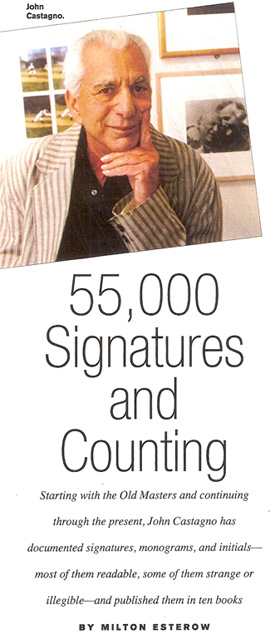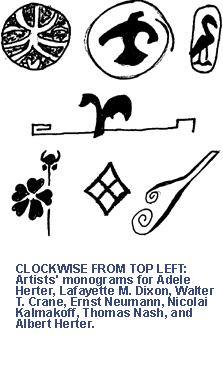 Whistler changed the way he signed his works with his name and monogram at least 12 times. Renoir and Warhol came up with eight versions; Matisse, seven; Picasso and Frida Kahlo, six; Kandinsky and de Kooning, five; Pollock and Rauschenberg, four.
Whistler changed the way he signed his works with his name and monogram at least 12 times. Renoir and Warhol came up with eight versions; Matisse, seven; Picasso and Frida Kahlo, six; Kandinsky and de Kooning, five; Pollock and Rauschenberg, four.
Who says so? John Castagno. Since 1980 he has compiled 55,000 signatures and monograms—most of them readable, some of them strange, ambiguous, or illegible—and published them in ten volumes.
“You have to be a little insane to do what I’ve been doing,” Castagno said with a smile.
Four of his compilations were released last May. Although they are not exactly best sellers—Castagno said he didn’t expect to live on his royalties—they are among the most frequently used reference books in galleries, museums, auction houses, and libraries around the world.
His books contain separate lists of artists who have signed their works with pseudonyms, nicknames, first and/or middle names, or with partial last names. Among them are Philip Guston (who signed his name both “Philip” and “Phillip”), Larry Rivers (“Larry”), and Mario Sironi (“SIR”). 
There are also signatures, monograms, and initials that are sometimes difficult to decipher. The hard ones include Jean-Michel Basquiat, John Chamberlain, Lucio Fontana, David Hockney, and Roy Lichtenstein.
“These books involve a tremendous amount of focus and solitude,” Castagno said. “You need complete silence, to be completely alone. At some point, now and then, you feel mentally burned out. I stop and take a nap and start again when I wake up. I do this 95 percent of my waking hours at home. I’m obsessed. I admit to it.”
Castagno’s books (all published by Scarecrow Press), which include references to biographical, bibliographical, and pictorial sources, have received kudos from prominent dealers and auctioneers.
“This is an invaluable tool in identification of works by artists who may no longer be well known, but there are even the most celebrated painters who have not at some time in their career changed the way they sign their work,” Michael Findlay, a director of Acquavella Galleries in New York, wrote in the foreword to Artists’ Monograms and Indiscernible Signatures II.
“The early paintings of both Picasso and Chagall bear signatures quite unlike those found on their mature paintings,” said Findlay. “Picasso included his surname, Ruiz (later dropped), and Chagall signed his name in Cyrillic lettering.”
Findlay pointed out that one of the most impressive features in the book is the section devoted to differentiating between works by artists sharing the same last name who signed their work with only that last name.
Castagno discovered many such artists, including Jesús Soto of Venezuela and Roberto Soto of Argentina; two Americans, Walter Hollis Stevens and Will Henry Stevens; and Gordon Smith, a Canadian, and Joseph B. Smith, an American.

Polly Sartori, senior vice president of 19th-century European paintings, drawings, watercolors, and sculpture at Sotheby’s, said of Castagno’s European Artists II: Signatures and Monograms from 1800: “An artist would have to have been pretty obscure not to have made this book.”
At 77, Castagno is an amiable, energetic man of medium height. Besides being a compiler of directories, he is also an artist, art dealer, and lecturer.
Born in Philadelphia, he left school to work with his father. “He had a small brick pointing business, which involved replacing mortar between the bricks and cleaning the face of the bricks,” Castagno said. “He never made much money but he managed. I went to art schools—the Pennsylvania Academy of the Fine Arts, the Samuel S. Fleisher Art Memorial, the Barnes.
“I became a serious painter in 1960. I did multimedia and hard-edge. I had a one-man show that traveled around the country in the 1970s, but I stopped painting in 1976. I ran my father’s business for some years. I was buying and selling art. I bought a Thomas Hart Benton for $60 at a small auction house in New Jersey and sold it years later for $95,000 at Christie’s.
“I was always looking for signatures. Sometimes I’d come across a monogram or a nickname or a symbol and I thought that it ought to be recorded. I felt I could fill a gap.”
His first book, Artists as Illustrators: An International Directory with Signatures and Monograms, 1800–Present, was published in 1989.
“I go to auctions and galleries and museums,” he said. “I copy signatures straight from the paintings. Most of the time I work with a magnifying glass to make the signatures visible. I reproduce them on 3-by-4-inch index cards in ink, and I put them into a computer. When working on a signature, I usually do it once. It’s rare for me to do it a second time. I work with different-size pens. The signature takes me less than a minute. It’s the research that takes a lot of time.
“With contemporary artists, I usually contact the galleries that handle them. Often they put me in touch with the artists. I make tons of phone calls. I’ve never had an artist turn me down. Sometimes they want to double-check to see how authentic I am. They’re never sure what my status is. They sometimes don’t take my word on the phone as to what I’m doing. A few Google me or call me back to check.
“The monograms always surprise me. They’re so odd. For example, the monograms of Adele Herter, an American artist, look like a plant or a fish. Walter T. Crane, an English artist, did a crane. Lafayette M. Dixon, an American artist, did what looks like a bird. Nicolai Kalmakoff, a Russian, made something that looks like a harp. Albert Herter did a lovely flower. Ernst Neumann, a German, made a bird on what may be a weather vane. Thomas Nash, an American, did a diamondshaped drawing with a cross in it.”
Castagno recently opened a Web site, ArtistsSignatures.com. He is working on seven new books—on African American artists, British and Irish artists, Canadian artists, and Asian artists, and the third volumes of his lists of American and European artists and of Artists’ Monograms and Indiscernible Signatures.
“I’m still coming across new additions,” he said. “In the last two months I found 2,000 new listings for future books. The project will never be totally comprehensive, but it is as comprehensive as I can make it. It’s a continuous thing. It’s endless.”
Why does he continue? “I started something and I must finish it to my satisfaction. I can’t leave things undone.”
How much longer? “I think I’ll stop after the seventh new book. You know, it’s been a labor of love for 27 years.”